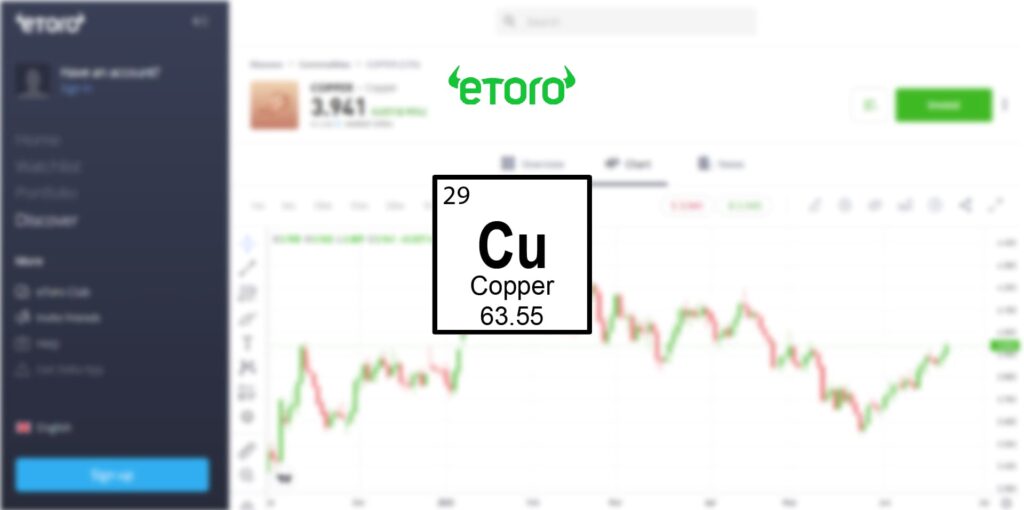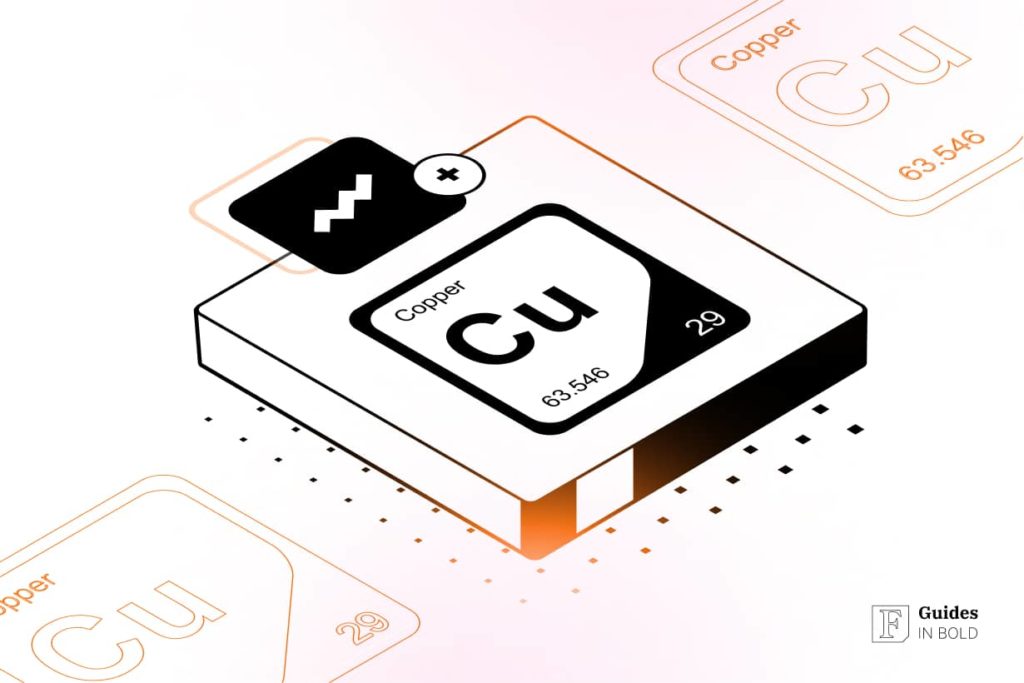Summary: As a highly sought-after commodity with exceptional properties and widespread applications, investing in copper is one of the most popular ways to get into trading and diversify your portfolio and a secure and convenient way to do so is through regulated online broker platforms, such as eToro.
Best Commodities Broker for Intermediate Traders and Investors
-
Invest in 30+ commodities and 3,000+ other assets including stocks and cryptocurrencies.
-
0% commission on buying stocks - buy in bulk or just a fraction from as little as $10. Other fees apply. For more information, visit etoro.com/trading/fees.
-
Copy top-performing traders in real time, automatically.
-
eToro USA is registered with FINRA for securities trading.
Copper as a commodity
Copper is a highly valued commodity that has garnered significant attention across various industries. Namely, its versatility and special conductivity make it essential in different applications, including electronics, transportation, and industrial machinery.
Copper’s price depends on supply and demand dynamics, global economic conditions, geopolitical events, and speculative trading. As a result, its cost is quoted on commodity exchanges, allowing investors to trade futures and options contracts.
The production of this commodity is a global endeavor, with leading contributors including Chile, Peru, China, the United States, and Australia. These countries, therefore, play a significant role in meeting the global copper demand.
Yet, copper prices can experience volatility due to fluctuations in supply and demand, macroeconomic conditions, and market speculation. Copper is thus often viewed as an economic indicator, reflecting the overall health of various industries and economic activity.
Who can invest in copper?
Investing in copper is simple, especially via a regulated broker platform like eToro. Still, doing so won’t mean purchasing actual copper physically. As an alternative, you will invest in contracts for differences (CFDs).
To clarify, CFDs represent financial instruments that provide investors with an option to gain profit without having to hold on to physical copper. Through them, you speculate on the price movements of commodities, generating profit based on accurate predictions.
How to invest in copper?
As mentioned, eToro is one of the most convenient broker platforms for commodity trading. Besides counting 30+ million investors, it’s also a secure service as it includes a license from Financial Conduct Authority (FCA), which ensure that you won’t have any legal issues trading.

How to invest in copper: Step-by-step process
Investing in copper through eToro is made simple by these four steps:
- Step 1: Register on eToro and verify your account (personal or business);
- Step 2: Decide on the amount of money to transfer to your eToro account;
- Step 3: Link your newly-made eToro account with your credit card and transfer money in one of the supported fiat currencies;
- Step 4: After choosing Commodities in the menu section, search for Copper and specify the amount you want to buy.
Disclaimer: 61% of retail investor accounts lose money when trading CFDs with this provider. You should consider whether you can afford to take the high risk of losing your money. This content is not intended for US users. eToro USA LLC does not offer CFDs, only real Crypto assets, Stocks and ETFs are available.
Best Commodities Broker for Intermediate Traders and Investors
-
Invest in 30+ commodities and 3,000+ other assets including stocks and cryptocurrencies.
-
0% commission on buying stocks - buy in bulk or just a fraction from as little as $10. Other fees apply. For more information, visit etoro.com/trading/fees.
-
Copy top-performing traders in real time, automatically.
-
eToro USA is registered with FINRA for securities trading.
Current price of copper
Should I invest in copper?
Deciding whether to invest in copper involves considering several factors. And to do so, it’s necessary to keep a keen eye on the following aspects of commodity investing:
- Market demand: Copper enjoys strong demand in construction, electrical equipment, and manufacturing industries. As economies grow and infrastructure develops, current projections estimate that copper will reach $1,067.33 by 2031 (TAM);
- Supply constraints: Copper production is restricted to just a few countries. This scarcity can lead to supply deficits and impact prices, and any disruptions in production can further affect supply levels;
- Volatility: Copper prices can be volatile due to factors like global economic conditions, supply-demand dynamics, and market speculation. Nevertheless, this volatility can present opportunities for gains, but it also poses risks;
- Portfolio diversification: Adding copper to an investment portfolio can provide diversification benefits, as its performance is influenced by factors different from those affecting traditional assets like stocks and bonds.
The best ways to invest in copper
When it comes to investing in copper, there are several options available. Each of these has its benefits and advantages, so it’s important to pick the approach that aligns with your investment goals and risk profile.
That said, here are some of the best ways to invest in copper:
- CFDs: With CFDs, investors can buy or sell copper at the current market price, aiming to profit from the price difference. CFDs offer flexibility and the potential to trade both long and short positions;
- Copper futures: Copper futures contracts allow investors to speculate on the future price of copper. These contracts are traded on commodity exchanges, such as the London Metal Exchange (LME) and the New York Mercantile Exchange (NYMEX);
- Exchange-traded funds (ETFs): Copper ETFs are investment funds that track the performance of copper prices. These funds typically hold physical copper or copper futures contracts. A primer example of copper ETFs includes the United States Copper Index Fund (CPER);
- Copper stocks: By investing in copper mining stocks, you can gain exposure to the industry and potentially benefit from rising copper prices. However, it’s important to conduct thorough research and consider factors such as the financial health of the company and its mining operations;
- Copper funds and mutual funds: Some mutual funds and specialized funds focus on commodities, including copper. These funds pool investors’ money to invest in a diversified portfolio of commodities, which can include copper.
What to avoid when investing in copper
When investing in copper, or any other commodity, it’s essential to be aware of potential pitfalls. Here are some common mistakes to avoid:
- Lack of research: Failing to conduct thorough research about the copper market, its drivers, and historical price trends can lead to uninformed investment decisions;
- Timing the market: Trying to time the market by predicting short-term price movements can be challenging and risky. Market timing requires accurate predictions, which is difficult even for seasoned investors;
- Overlooking risk management: Commodities, including copper, can be volatile. Failing to establish a risk management strategy, such as setting stop-loss orders or diversifying your investments, can leave you exposed to significant losses;
- Ignoring global factors: It’s essential to understand that copper prices are influenced by global economic conditions, geopolitical events, and government policies before making misinformed investment decisions;
- Overconcentration: Placing a significant portion of your investment portfolio in a single commodity like copper can increase risk. You should, instead, diversify your portfolio with different asset classes to mitigate risk.
The bottom line
Investing in copper can diversify your portfolio and potentially yield significant returns due to its extensive industrial applications and growing demand in sectors like renewable energy and electric vehicles. However, it’s crucial to be aware of the market’s volatility and conduct thorough research before investing.
Disclaimer: The content on this site should not be considered investment advice. Investing is speculative. When investing, your capital is at risk.
FAQs about how to invest in copper
Can you invest in copper?
Yes, anyone can invest in copper through a regulated broker platform like eToro.
How to invest in copper?
To invest in copper securely, conveniently, and fast, it’s best to take advantage of eToro’s services, as it holds an FCA license.
Where to invest in copper?
eToro is one of the most convenient platforms through which you can invest in commodities such as copper.
Is investing in copper safe?
Although experts consider copper a smart investment to diversify a portfolio, putting money in it includes its own risk, as it’s a volatile market that depends on various factors.
Is copper a good investment?
Whether copper is a good investment or not depends on various factors such as market conditions, demand-supply dynamics, individual investment goals, and risk tolerance.
What are the primary factors influencing copper prices?
Copper prices are influenced by various factors, including global supply and demand dynamics, economic growth indicators, geopolitical events, and technological advancements.
Best Commodities Broker for Intermediate Traders and Investors
-
Invest in 30+ commodities and 3,000+ other assets including stocks and cryptocurrencies.
-
0% commission on buying stocks - buy in bulk or just a fraction from as little as $10. Other fees apply. For more information, visit etoro.com/trading/fees.
-
Copy top-performing traders in real time, automatically.
-
eToro USA is registered with FINRA for securities trading.





